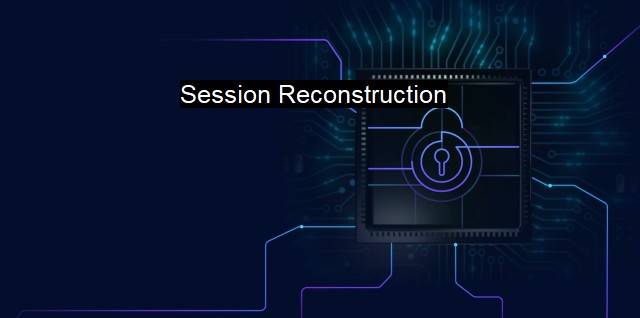What is Session Reconstruction?
The Vital Role of Session Reconstruction in Cybersecurity: Tracing Network Traffic to Identify Threats and Breaches
Session reconstruction refers to the process used in cybersecurity to rebuild and analyze a past user's activity or activities during a certain period by collecting event data. In simple terms, it involves recreating each individual action taken by a user during a specific session or sessions.In cybersecurity and antivirus contexts, session reconstruction plays a significant role in identifying, rectifying, and hindering security breaches. It uses gathered information to answer the critical questions of what happened, why it happened, and how it happened, thus illuminating any security breaches that may have occurred.
In the complex digital landscape, companies ' systems typically interact with countless web requests from users daily. Each request assists in the performance of different system functionalities. While each connection is pivotal, they also offer an entry point for cyber threats.
Consequently, leading cybersecurity and antivirus solutions heavily rely on session reconstruction for effective operation, primarily focusing on network packets. You’ll often see it deployed in Internet Protocol (IP) based networks where the goal is to identify any irregular or dubious network patterns. When a threat is recognized, this system rebuilds the entire history of that particular network traffic, facilitating potential infection or breach detection.
Session reconstruction is integral to proactive threat hunting, offering an effective tool for cybersecurity teams to understand better latent threats within an organization's computing landscape. With the ability to recreate and review past sessions in detail and sequence, teams can detect and identify past threats, as well as mitigating potential future threats.
It’s particularly beneficial for incident response procedures. If a system's integrity is compromised, the incident response team can leverage information provided by the session reconstruction to identify how the system's security was breached. This information can provide crucial insights regarding malware installation on a machine, or a hacker's activities within the operating system, which significantly boosts recovery efforts and helps prevent future incidents.
The bare details provided by basic alerts can seem unclear, but by utilizing session reconstruction way, investigators are able to get a complete picture of a series of events, assisting them to understand the cause, nature, and intensity of any given threat. From irregular application behavior to exposed vulnerabilities in the system, session reconstruction can aid in revealing an array of security pitfalls.
Session reconstruction forms the basis for network forensics, presenting an archived record chain of a particular session. The insights derived from these archives can provide an understanding of unwanted application behaviors, network abnormalities, intrusion attempts, and malware operations. this knowledge helps teams to proactively strategize implementing robust security controls to protect critical data from potential cybercriminals.
Securing networks and systems is a fundamental pursuit for organizations concerned with maintaining an untarnished brand image, promoting digital trust, and averting possible legal liabilities over lost or compromised data. In this pursuit, session reconstruction emerges as a key tool, providing an effective way to unwind past sessions to test a system's vulnerabilities, investigate incident details, and prepare accordingly.
It is necessary to note that reconstructing a session does not necessarily imply that its outcome can always be modified. For organizations to derive the full benefit of session reconstruction, a filter must be applied against data irrelevance, redundancy, and inaccuracy. Indeed, for this to be successfully executed, it requires substantial precision, robust systems and infrastructure, and skilled & experienced personnel.
To sum up, session reconstruction within a cybersecurity and antivirus setting is about rebuilding the chain of events during a certain timeframe within a user’s session for analysis. Its main goal is to provide an in-depth understanding of any events surrounding a particular security breach or incidents for more effective planning and decision-making when it comes to future security countermeasures.

Session Reconstruction FAQs
What is session reconstruction in cybersecurity?
Session reconstruction in cybersecurity is the process of piecing together the details of a user's online activity, including the websites visited, data transferred, and any actions taken, in order to investigate or prevent potential security threats.Why is session reconstruction important for antivirus software?
Session reconstruction is crucial for antivirus software because it helps detect and analyze malicious activities on a user's device. By reconstructing a session, antivirus software can identify and analyze potentially harmful network traffic, allowing it to block or quarantine any suspicious activity.What tools or techniques are used for session reconstruction?
Several tools and techniques are used for session reconstruction, including network sniffers, packet analyzers, log files, and traffic flow analysis. These tools can help extract data from network traffic and reconstruct a session, allowing cybersecurity professionals to investigate potential threats and gather evidence for forensic analysis.Can session reconstruction be used to track individual user activity?
Session reconstruction can be used to track individual user activity, but it must be done in accordance with legal and ethical standards. Cybersecurity professionals and law enforcement agencies must follow strict guidelines and obtain appropriate warrants before using session reconstruction to monitor or investigate specific individuals, and they must ensure that any information collected is kept confidential and protected from unauthorized access.| | A | | | B | | | C | | | D | | | E | | | F | | | G | | | H | | | I | | | J | | | K | | | L | | | M | |
| | N | | | O | | | P | | | Q | | | R | | | S | | | T | | | U | | | V | | | W | | | X | | | Y | | | Z | |
| | 1 | | | 2 | | | 3 | | | 4 | | | 7 | | | 8 | | |||||||